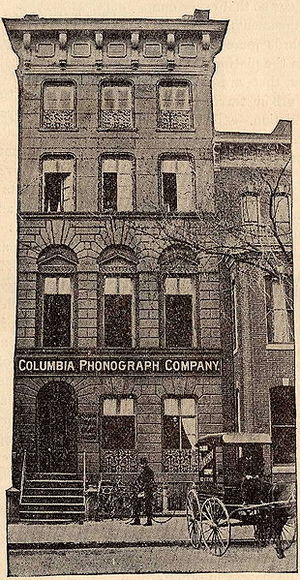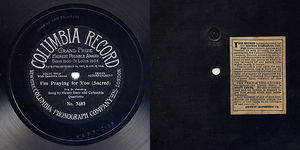Columbia Record Company
The Columbia Record Company was one of the largest record companies in the world during the 20th century. It was also one of the first record and phonograph companies. Like so many companies in the music industry, it has a complicated history. It was originally the Columbia Phonograph Company, and sold phonographs in the Washington, D.C. area. Later, it merged with the American Graphophone Company, which held the rights to an improved form of cylinder phonograph. After the merger of the two in 1893, Columbia began manufacturing cylinder phonographs and records in a plant in Connecticut. The head of the company, Edward Easton, was a shrewd businessman who made Columbia into a true competitor for Thomas Edison’s business. The two competed fiercely, with both regularly introducing improved forms of the phonograph and better records. One of Columbia’s innovations was a mechanical sound amplifier that produced louder sounds without loudspeakers or electronics (which were still many years in the future). Although it did not work very well, it could amplify sound a little bit.
In the early 1900s, Columbia also faced a new rival—the Victor Talking Machine Company who manufactured disc records. Columbia responded by offering both discs and cylinders, deciding to let the public decide which format they liked best. A few years later, Columbia dropped cylinders entirely. The company continued to grow, and at its peak in the early 1900s, Columbia was able to hire the famous radio engineer Guglielmo Marconi, who consulted on research projects. Columbia-Marconi Velvet Tone records, which appeared on the market in the summer of 1906, were one of the fruits of the association with the great inventor.
But the introduction of radio broadcasting after 1920 sent Columbia into a tailspin. Sales dropped so dramatically that the company stopped record production in 1932. The record-pressing branch of the company was bought by a radio manufacturer, Grigsby-Grunow, and the phonograph manufacturing arm was eventually purchased by the Columbia Broadcasting Company (CBS), which happened to have Columbia in the name but was no relation.
Columbia Record Company, as it was now known, survived the Great Depression of the 1930s, but just barely. To try to win back classical music fans, it introduced a large, 12-inch diameter long playing disc that was a complete flop (Columbia would later reintroduce the modern form of long playing record in 1948). It struggled for many years before returning to prominence during World War II.
Columbia (renamed CBS Records by the late 1960s) expanded rapidly when the record market revived after 1945. It introduced a new subsidiary label, Epic, and started a mail-order record club called Columbia House. In 1968, the company launched a partnership with the Sony Corporation in Japan that would later prove much more important. Sony helped sell CBS records in Japan through the 1970s. In 1982 CBS Records helped Sony launch a new product called the Compact Disc. In the 1980s Sony became so successful it was able to purchase CBS Records, which still operates today as part of the Sony Music Entertainment.

